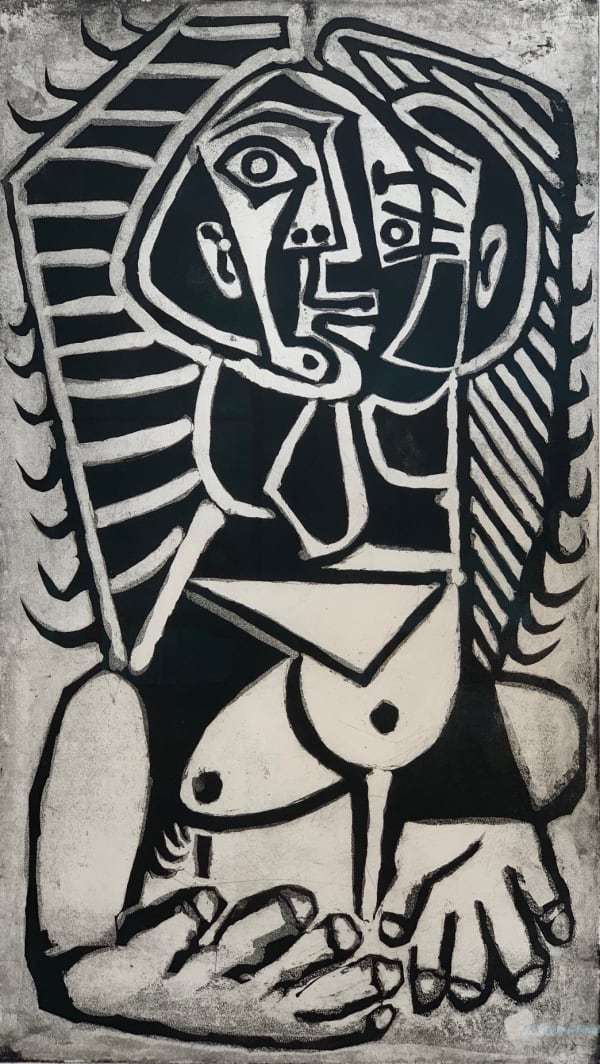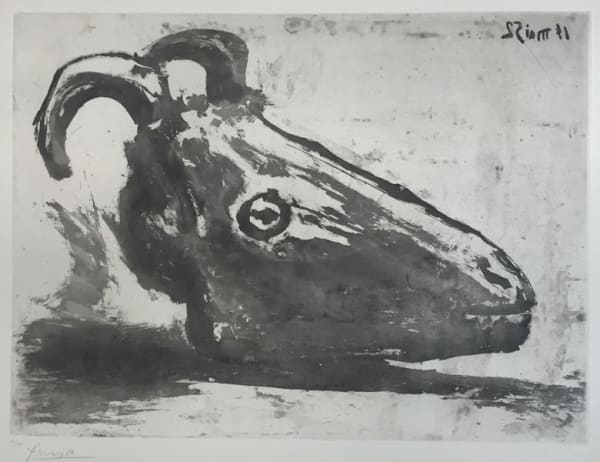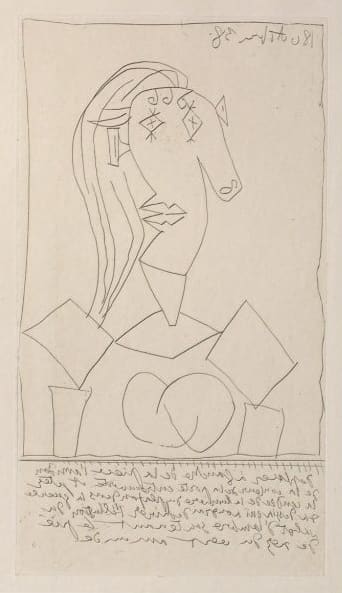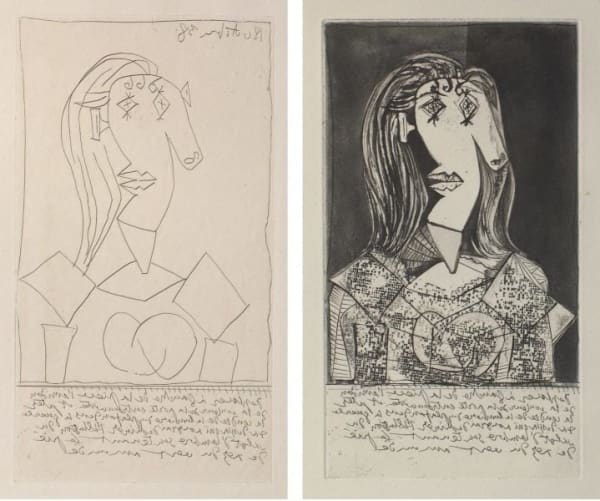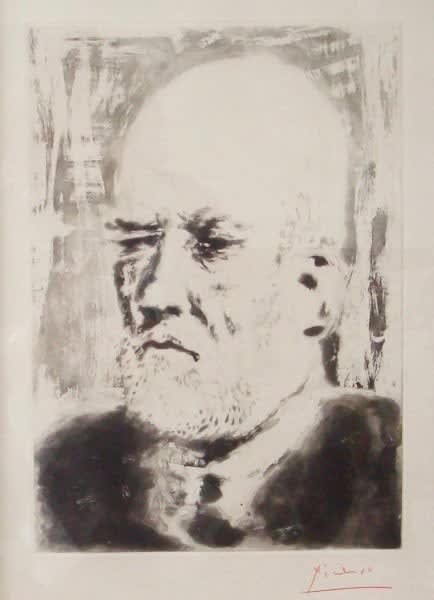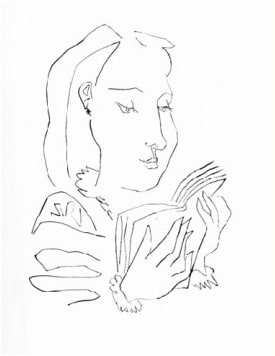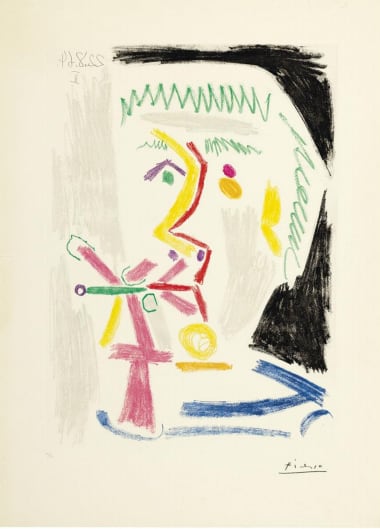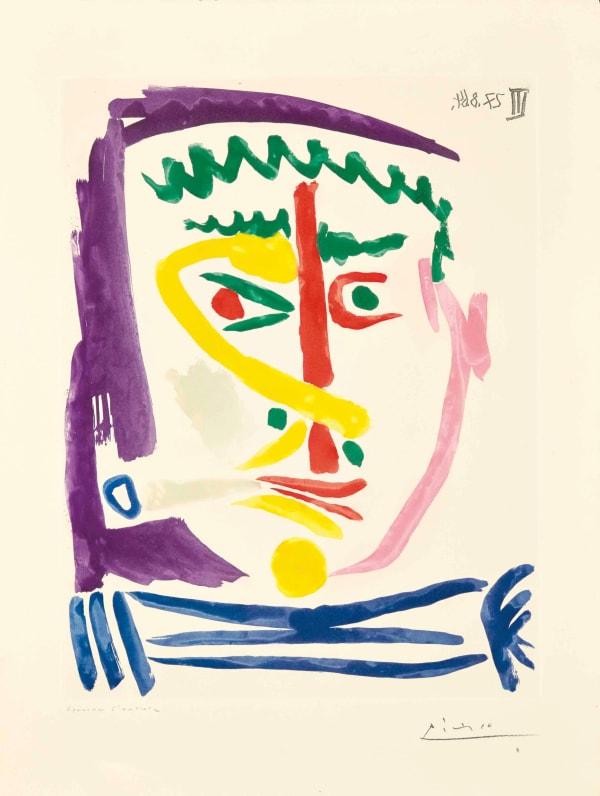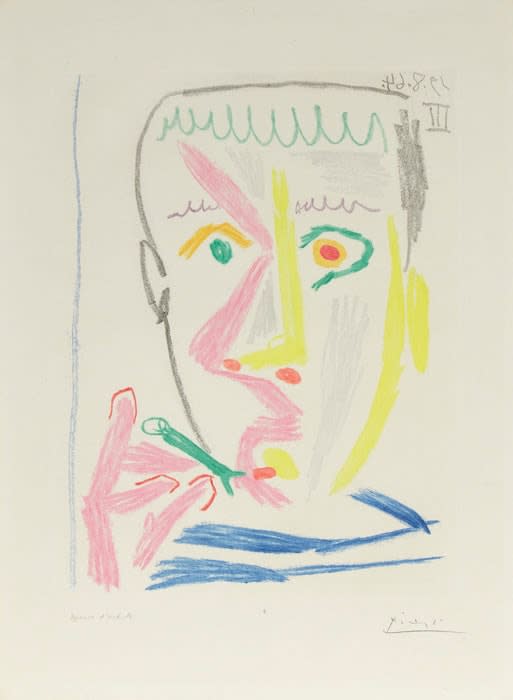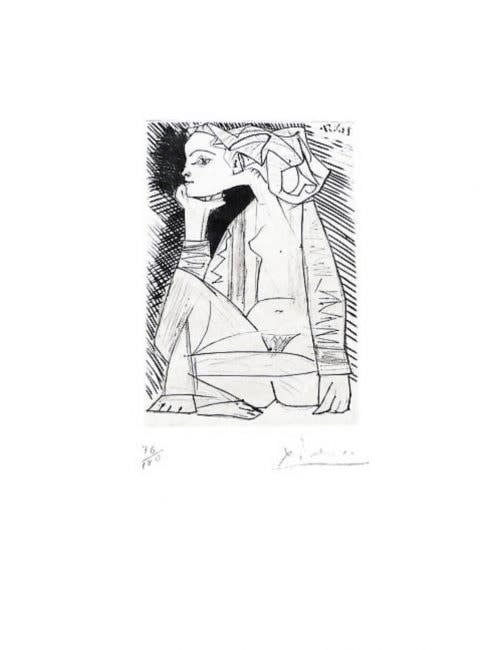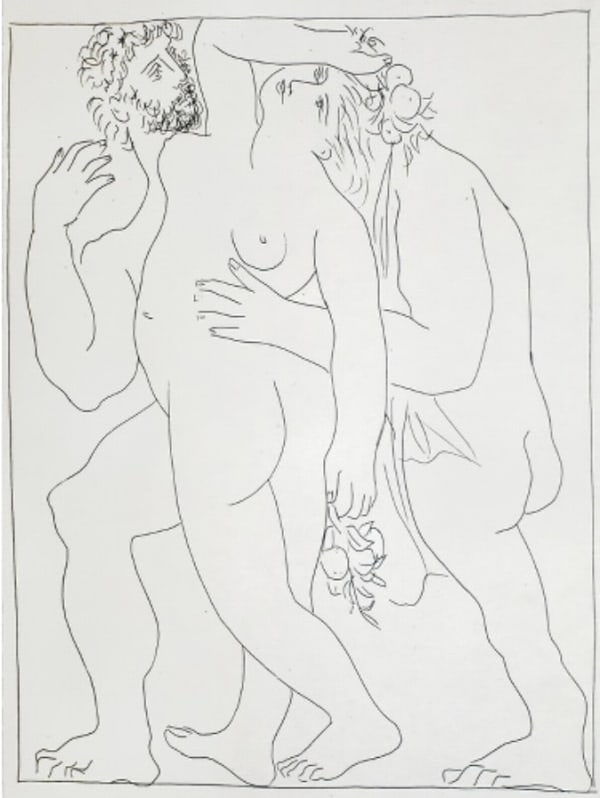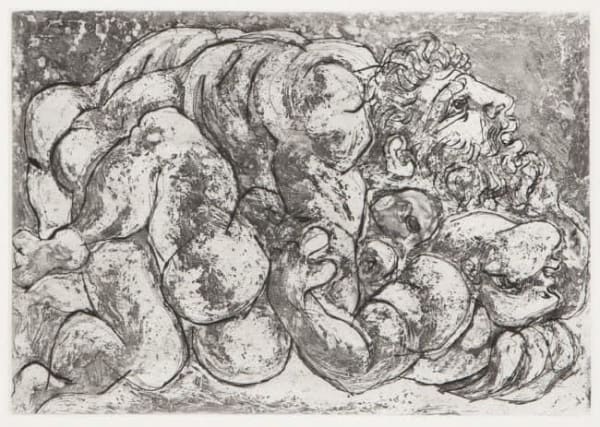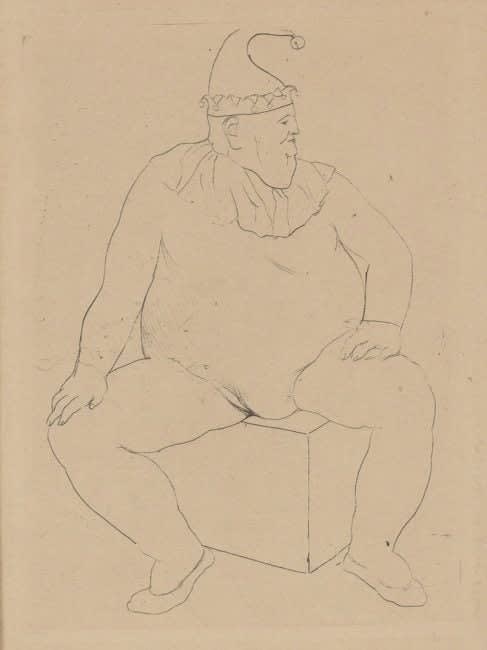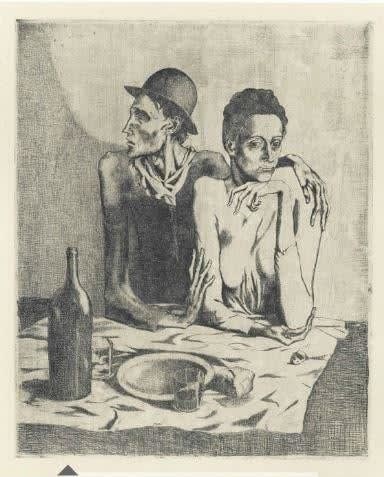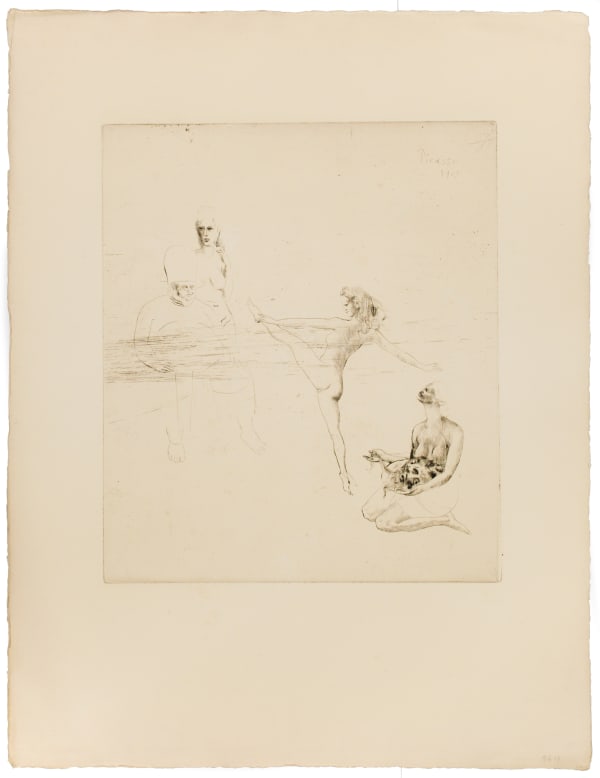
Pablo Picasso
Hand signed in pencil
Printer (Crommelynck) Blindstamp
55.9 x 76.2 cm
Bacchanale is a compelling aquatint by Pablo Picasso that fuses mythological subject matter with his late-career printmaking mastery. Created around 1959–60, this work captures the spirit of Dionysian revelry in a distinctly modern key—combining painterly gesture, grotesque humor, and narrative ambiguity. The bacchanal, a classical motif of intoxication, sensuality, and ritual, had been a recurring theme for Picasso since the early 20th century. In this aquatint, he brings it into the domain of his own psychological and artistic theatre.
The scene is set in a shallow architectural space—suggestive of a Mediterranean courtyard—with vine-laced trellises overhead and classical columns anchoring the composition. Three figures dominate the foreground: a standing nude male with a wreath of leaves, a seated nude playing a pipe, and a more modern, clothed figure reclining on a chair with a bored or drunken expression.
Picasso renders these figures with expressive distortion. The forms are massive yet loose, their outlines softened by the velvety, tonal textures of aquatint and drypoint. The male nude to the left, erect and frontal, appears both classical and caricatured. The seated piper at the center evokes ancient satyr iconography but is rendered with a kind of broken vulnerability. The figure at right—a stocky man in a striped vest and laurel crown—appears incongruously modern, bridging the world of myth and reality.
The color palette is muted—greys, blacks, sea greens, and flesh tones—accentuating the dreamlike quality of the scene. Broad strokes of white ink give the impression of light, air, and abstraction, while deep etching textures impart weight and materiality to the figures.
The bacchanal had long fascinated Picasso, particularly for its connection to classical antiquity, the body, and performative ritual. In earlier works—such as his neoclassical paintings of the 1920s or the Vollard Suite etchings of the 1930s—he used bacchic scenes to explore eroticism, mythology, and the role of the artist as voyeur and participant.
In Bacchanale, the atmosphere is less overtly erotic and more satirical. These revelers seem tired, awkward, or contemplative rather than ecstatic. The playful hedonism associated with bacchic scenes has become subdued, almost theatrical. This shift reflects the sensibility of Picasso’s late style—introspective, fragmented, and often ironic.
By including a figure in contemporary dress alongside mythological characters, Picasso collapses temporal boundaries. The bacchanal becomes not a distant myth, but a recurring cycle of human behavior—sensuality, absurdity, boredom, and ritual embedded in every age.
This aquatint is a prime example of Picasso’s extraordinary command of printmaking. Unlike linear etching or bold lithography, aquatint allows for subtle tonal variation—ideal for atmospheric depth and painterly textures. Picasso exploited this to full effect, layering areas of deep shadow, ghostly light, and fuzzy form with remarkable precision.
His collaboration with master printers at the Atelier Crommelynck in Paris during this period was central to his late print production. He treated the plate not as a static surface but as a living canvas, constantly revising, scraping, and burnishing to achieve a desired emotional register.
Drypoint, used alongside aquatint here, adds another dimension: sharp, incised lines—seen most clearly in the hair, features, and foliage—impart immediacy and graphic tension to the otherwise fluid surface.
Bacchanale reveals Picasso’s unmatched ability to breathe life into age-old themes through the medium of print. It is a work that is at once mythological and modern, humorous and haunting. Through his deft handling of aquatint and drypoint, Picasso transforms a classical subject into a rich allegory of human indulgence and artistic reflection—cementing his role not only as a master of modern art, but also as one of the greatest printmakers of the 20th century.
For more information, contact our galleries via the inquiry form below.
-
 Pablo PicassoTête Homme au Maillot Rayé, 1964
Pablo PicassoTête Homme au Maillot Rayé, 1964 -
 Pablo PicassoEcce Homo, d’Après Rembrandt, 1970
Pablo PicassoEcce Homo, d’Après Rembrandt, 1970 -
 Pablo PicassoCaricature of General de Gaulle and Two Women, from: Series 347| Caricature du général de Gaulle et deux femmes, 1968
Pablo PicassoCaricature of General de Gaulle and Two Women, from: Series 347| Caricature du général de Gaulle et deux femmes, 1968 -
 Pablo PicassoNature Morte au Citron et au Pichet Rouge, 1955
Pablo PicassoNature Morte au Citron et au Pichet Rouge, 1955 -
 Pablo PicassoTorse de Femme, 1953
Pablo PicassoTorse de Femme, 1953 -
 Pablo PicassoLe Crane de Chevre, 1952
Pablo PicassoLe Crane de Chevre, 1952 -
 Pablo PicassoBuste de Femme (Dora Maar) State I (Bloch 308), 1938
Pablo PicassoBuste de Femme (Dora Maar) State I (Bloch 308), 1938 -
 Pablo PicassoDora Maar, 1938
Pablo PicassoDora Maar, 1938 -
 Pablo PicassoPortrait of Vollard II, 1937
Pablo PicassoPortrait of Vollard II, 1937 -
 Pablo PicassoFemme Lisant, 1948
Pablo PicassoFemme Lisant, 1948 -
 Pablo PicassoL'Homme à la Guitare, 1915-29
Pablo PicassoL'Homme à la Guitare, 1915-29 -
 Pablo PicassoFumeur A La Cigarette Verte, 1964
Pablo PicassoFumeur A La Cigarette Verte, 1964 -
 Pablo PicassoFumer III, 1964
Pablo PicassoFumer III, 1964 -
 Pablo PicassoFumer , 1964
Pablo PicassoFumer , 1964 -
 Pablo PicassoFemme Assise en Tailleur, 1951
Pablo PicassoFemme Assise en Tailleur, 1951 -
 Pablo PicassoBuste de Femme (Dora Maar) State IX (Bloch 308), 1938
Pablo PicassoBuste de Femme (Dora Maar) State IX (Bloch 308), 1938 -
 Pablo PicassoTete de Femme, 1933
Pablo PicassoTete de Femme, 1933 -
 Pablo PicassoVertumne Poursuit Pomone de son Amour, 1930
Pablo PicassoVertumne Poursuit Pomone de son Amour, 1930 -
 Pablo PicassoAccouplement I, 1933
Pablo PicassoAccouplement I, 1933 -
 Pablo PicassoSaltimbanque au Repos (Bloch 10), 1905
Pablo PicassoSaltimbanque au Repos (Bloch 10), 1905 -
 Pablo PicassoLe Repas Frugal, 1904
Pablo PicassoLe Repas Frugal, 1904 -
 Pablo PicassoSalomé, 1905
Pablo PicassoSalomé, 1905
Join our mailing list
* denotes required fields
We will process the personal data you have supplied in accordance with our privacy policy (available on request). You can unsubscribe or change your preferences at any time by clicking the link in our emails.
This website uses cookies
This site uses cookies to help make it more useful to you. Find out more about cookies.




